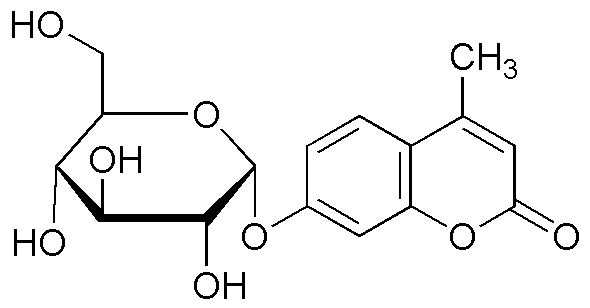4-Methylumbelliferyl-a-D-glucopyranoside is widely utilized in research focused on:
- Enzyme Activity Assays: This compound serves as a substrate for various glycosidases, enabling researchers to measure enzyme activity in biochemical assays. Its fluorescent properties allow for easy detection and quantification.
- Cell Biology: It is used to study cellular uptake mechanisms and glycosylation processes in living cells, providing insights into cellular metabolism and function.
- Food Industry: This chemical can be applied in food testing to detect specific enzymes, helping ensure food safety and quality by monitoring enzymatic activity in food products.
- Biomedical Research: It plays a role in studying carbohydrate metabolism and related diseases, aiding in the development of therapeutic strategies for conditions like diabetes.
- Fluorescent Probes: The compound is utilized in developing fluorescent probes for imaging applications, enhancing the visualization of biological processes in live cells and tissues.
General Information
Properties
Safety and Regulations
Applications
4-Methylumbelliferyl-a-D-glucopyranoside is widely utilized in research focused on:
- Enzyme Activity Assays: This compound serves as a substrate for various glycosidases, enabling researchers to measure enzyme activity in biochemical assays. Its fluorescent properties allow for easy detection and quantification.
- Cell Biology: It is used to study cellular uptake mechanisms and glycosylation processes in living cells, providing insights into cellular metabolism and function.
- Food Industry: This chemical can be applied in food testing to detect specific enzymes, helping ensure food safety and quality by monitoring enzymatic activity in food products.
- Biomedical Research: It plays a role in studying carbohydrate metabolism and related diseases, aiding in the development of therapeutic strategies for conditions like diabetes.
- Fluorescent Probes: The compound is utilized in developing fluorescent probes for imaging applications, enhancing the visualization of biological processes in live cells and tissues.
Documents
Safety Data Sheets (SDS)
The SDS provides comprehensive safety information on handling, storage, and disposal of the product.
Product Specification (PS)
The PS provides a comprehensive breakdown of the product’s properties, including chemical composition, physical state, purity, and storage requirements. It also details acceptable quality ranges and the product's intended applications.
Certificates of Analysis (COA)
Search for Certificates of Analysis (COA) by entering the products Lot Number. Lot and Batch Numbers can be found on a product’s label following the words ‘Lot’ or ‘Batch’.
*Catalog Number
*Lot Number
Certificates Of Origin (COO)
This COO confirms the country where the product was manufactured, and also details the materials and components used in it and whether it is derived from natural, synthetic, or other specific sources. This certificate may be required for customs, trade, and regulatory compliance.
*Catalog Number
*Lot Number
Safety Data Sheets (SDS)
The SDS provides comprehensive safety information on handling, storage, and disposal of the product.
DownloadProduct Specification (PS)
The PS provides a comprehensive breakdown of the product’s properties, including chemical composition, physical state, purity, and storage requirements. It also details acceptable quality ranges and the product's intended applications.
DownloadCertificates of Analysis (COA)
Search for Certificates of Analysis (COA) by entering the products Lot Number. Lot and Batch Numbers can be found on a product’s label following the words ‘Lot’ or ‘Batch’.
*Catalog Number
*Lot Number
Certificates Of Origin (COO)
This COO confirms the country where the product was manufactured, and also details the materials and components used in it and whether it is derived from natural, synthetic, or other specific sources. This certificate may be required for customs, trade, and regulatory compliance.


